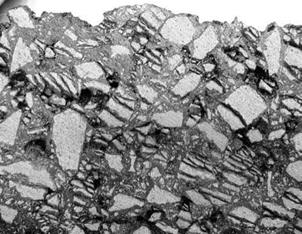Requirements for SMA Materials
A distinctive feature of stone matrix asphalt (SMA) components is their high quality. In this chapter we shall have a look at the requirements for those materials in various countries. Comparing them may be interesting because of the diversity of emphases different countries place on individual conditions.
Consequently, the following components will be subsequently discussed in detail:
• Aggregates
• Binders
• Stabilizers
• Reclaimed asphalt
• Other additives
5.1 REQUIREMENTS FOR AGGREGATES
The requirements for aggregates are quite diverse, and they chiefly concern fundamental properties that influence the performance of SMA and are attributed to the size of the grains. This has given rise to a variety of requirements for particular fractions—some for coarse (active) aggregates and other for fine ones. The requirements for fillers have been defined in Chapters 2 and 3.
One may find that almost everywhere these requirements center around the following properties:
• Coarse aggregate: hardness (resistance to fragmentation or crushing), percentage crushed, shape of grains, polishing resistance, and resistance to external factors (e. g., water, frost, deicers)
• Fine aggregate: angularity, amount of dust, and absence of swelling fractions in dusts
• Fillers: stiffening properties—difference in softening points (SPs), absence of swelling fractions, and air voids in a compacted filler.
Taking into account the type of aggregate skeletons required for SMAs, the primary property seems to be resistance to crushing. This resistance is often assessed using the very popular Los Angeles abrasion test (L. A. index). The range of the allowable LA index in national specifications typically varies from 20 to 30%; however, many publications from North America reported that some successful SMAs have aggregates with LA index values that are greater than 30%.
In one report (Celaya and Haddock, 2006) the authors express their opinion that the LA index is not the only important property of coarse aggregates for SMA. Besides the LA index, one should take into account the Micro-Deval test, which is conducted using water[19] and the Strategic Highway Research Program (SHRP) Superpave Gyratory Compactor (SGC) compaction degradation. This difference between the LA index and Micro-Deval test can show the aggregates that are sensitive to crushing in the presence of water. Finally, the results from the LA index, Micro-Deval test, and SGC degradation test provide the best way to select suitable coarse aggregates for use in SMA mixtures. Comprehensive reviews of coarse aggregate test methods are available in the published literature such as Fowler et al. (2006) and White et al. (2006).
In Germany, the Schlagzertrummerungswert (EN 1097-2, Part 6) method is used instead of or together with the LA index. In general, resistance to crushing is crucial and must be tested because the use of weak aggregates may result in poor performance of the whole layer (Figure 5.1).
For the fine aggregate portion, the most commonly specified property is angularity. This can be tested using different methods; common ones include the flow rate method as in European Standard EN 933-6 (results in seconds, shown as Ecs) or the measurement of voids in uncompacted aggregate as in AASHTO T 304 (results in % [v/v], known as fine aggregate angularity [FAA]). Obviously other methods are used and could also be good indicators of angularity. Johnson et al. (2004) have conducted interesting research to evaluate the influence of FAA and
|
FIGURE 5.1 An example of the use of very weak aggregates in an SMA mixture; sample after wheel tracking test shows fractured aggregate particles. (Photo courtesy of Krzysztof Blazejowski.) |
other variables on asphalt mix performance. That study confirmed that FAA is a good tool to predict dynamic modulus and rut resistance.
The requirements for filler, besides gradation, are focused on analyses of clay and silt in the filler and on the stiffening properties represented by an increase of the SP and Rigden voids. The specific areas of filler are gradually being withdrawn from specifications in some countries (e. g., Poland and Finland). Applications of different raw materials as fillers were described in Chapter 3. Some waste materials, such as coal fly ash, waste ceramics, and steel slag, have also been tested, and the results indicate a good potential for use in SMA (Muniandy et al., 2009).
The requirements for aggregates in selected countries are described throughout this chapter. The data are divided into two parts—that for CEN countries (mainly European Union) and that for the United States. A more comprehensive record of data would surpass the scope of this book.







Leave a reply